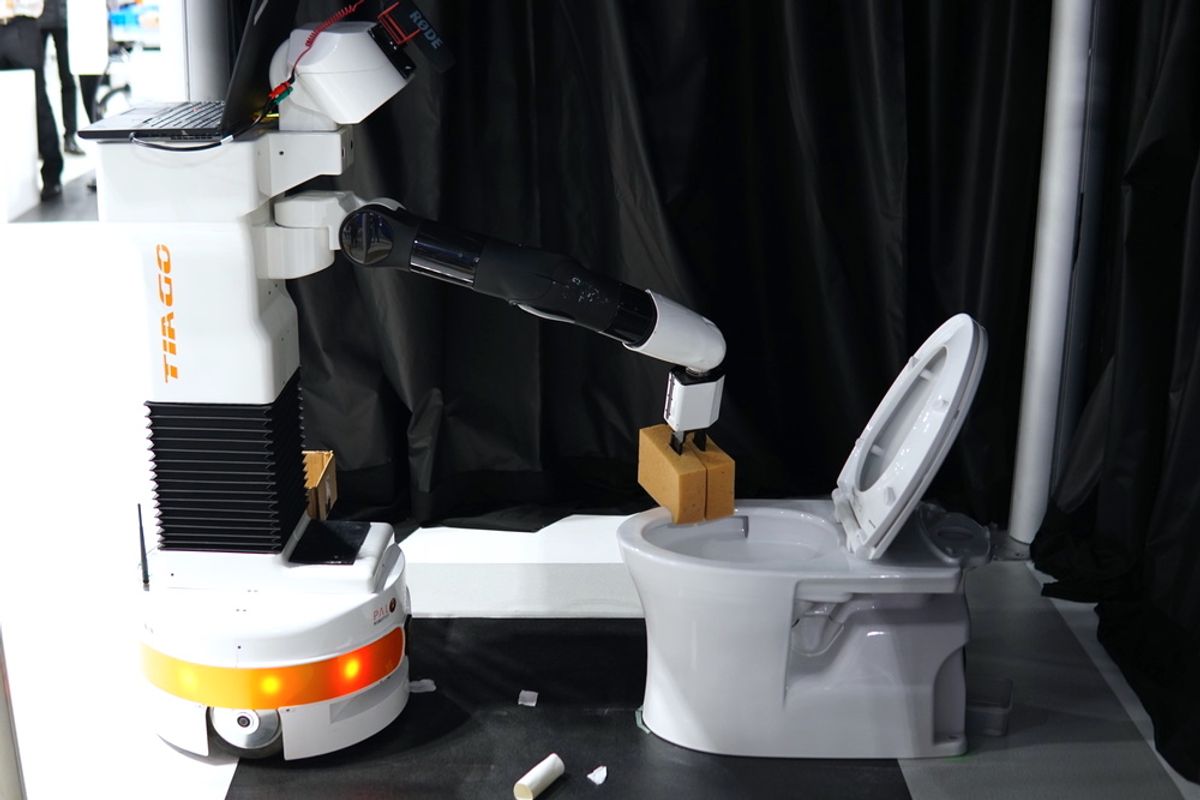A useful general home robot, as far as I’m concerned, needs to be able to do three things: fold laundry, wash dishes, and clean toilets. That’s all it would take to make me happy. We’ve seen some attempts at both laundry folding and washing dishes, but not a lot of bathroom cleaning. Now, thanks to the World Robot Summit (WRS) in Japan, robots are finally tackling this task. As part of a competition held at the event, robots had to clean water from around a toilet and clean trash off the floor. Team Homer at the University of Koblenz-Landau, Germany, managed to get things done with a TIAGo mobile manipulator that you could (almost) picture cleaning up your bathroom as well.
During the competition, judges randomly sprinkled water on and around a toilet. Teams had to clean at least 80 percent of the liquid and remove trash from the floor in order to get full points. The video below shows Team Homer’s run with a PAL Robotics TIAGo:
First the robot approaches the toilette, then he detects the toilet seat to clean it. The toilet seat is assumed to be planar and then estimated in the RGB-D data. The resulting segment is closed and thinned using morphology. The resulting line then serves as input for the end effector positions. We proposed the use of an sponge end effector. With this end effector we can soak up the liquid on the toilet seat and the ground, at the same time we are able to pick up small pieces of toilet paper as well as empty paper rolls. The picked trash is stored in a bin mounted at the side of the robot. In the end the robot cleans the floor.

There were a variety of different approaches that teams used for this challenge at the WRC, including building a robotic system around the entire bathroom to handle the cleaning tasks. Honestly, that’s probably a faster and more reliable way to solve the problem, but it’s also far less practical, which is why we’re much more impressed with Team Homer’s use of a mobile manipulator that was modified only with a sponge.
TIAGo isn’t particularly fast at the cleaning task, but as with UC Berkeley’s famous laundry folding PR2, speed shouldn’t be a significant factor since the idea would be that the robot just does its work when you’re not around. Robot vacuums are the same—who cares if it takes the thing an hour or two to do a job you could do in 20 minutes if it just runs while you’re off at work?
Having said that, we’re still a very long way from useful autonomous mobile manipulation in the home, and it’s more likely that we’ll see robots doing tasks like this in places like hotels, where each room is identical, there are lots of rooms, and cleaning has to happen every day. It’s situations like these in which robots can show their worth: Predictable environments, repetitive tasks, and enough work to do over a long enough period of time that an expensive robot has a reasonable chance of being a good investment. You could imagine that in the (sort of) near future, hotels might use teams of humans and robots to service rooms, with the humans doing the tricky tidying up (and probably making the bed), while the robots do the floors and bathroom.
The biggest obstacle to cleaning robots like these is, sadly, probably not related to robotics hardware or software. It’s that humans are really good at cleaning bathrooms, really fast at cleaning bathrooms, and really cheap at cleaning bathrooms. We don’t want to clean bathrooms, but we’ll do it anyway, and it’s likely that most of us won’t be willing to pay all that much for a robot that’s able to do that and nothing else.
[ Team Homer ] via [ WRC ]
Evan Ackerman is a senior editor at IEEE Spectrum. Since 2007, he has written over 6,000 articles on robotics and technology. He has a degree in Martian geology and is excellent at playing bagpipes.



